Rheology Impact of Various Hydrophilic-Hydrophobic Balance (HLB) Index Non-Ionic Surfactants on Cyclopentane Hydrates
Abstract
:1. Introduction
1.1. Cyclopentane as Hydrate Former
1.2. SPANS and TWEENS Surfactants
1.3. Sorbitan Ester and Derivatives for Cyclopentane Hydrate Control
2. Materials and Methods
2.1. Materials and Sample Preparation
2.2. Experimental Apparatus and Rheology Measurement Procedure
3. Results and Discussion
3.1. Hydrate Seeds and Volume
3.2. Impact of Oil-Soluble Span 80 Surfactant on CP Hydrate Slurry Viscosity Giving
4. Conclusions
Author Contributions
Funding
Acknowledgments
Conflicts of Interest
References
- Koh, C.A. Towards a fundamental understanding of natural gas hydrates. Chem. Soc. Rev. 2002, 31, 157–167. [Google Scholar] [CrossRef]
- Khan, M.S.; Bavoh, C.; Lal, B.; Keong, L.K.; Mellon, N.; Bustam, M.A.; Shariff, A.M. Application of Electrolyte Based Model on Ionic Liquids-Methane Hydrates Phase Boundary. IOP Conf. Ser.: Mater. Sci. Eng. 2018, 458, 012073. [Google Scholar] [CrossRef]
- Nashed, O.; Dadebayev, D.; Khan, M.S.; Bavoh, C.; Lal, B.; Shariff, A.M. Experimental and modelling studies on thermodynamic methane hydrate inhibition in the presence of ionic liquids. J. Mol. Liq. 2018, 249, 886–891. [Google Scholar] [CrossRef]
- Bavoh, C.B.; Lal, B.; Osei, H.; Sabil, K.M.; Mukhtar, H. A review on the role of amino acids in gas hydrate inhibition, CO2 capture and sequestration, and natural gas storage. J. Nat. Gas. Sci. Eng. 2019, 64, 52–71. [Google Scholar] [CrossRef]
- Bavoh, C.B.; Lal, B.; Keong, L.K. Introduction to Gas Hydrates. In Chemical Additives for Gas Hydrates; Green Energy and Technology; Springer: Cham, Switzerland, 2020; pp. 1–20. ISBN 978-3-030-30749-3. [Google Scholar]
- Khan, M.S.; Bavoh, B.C.; Mohammad, A.R.; Bhajan, L.; Quainoo, A.K.; Abdulhalim, S.M. Assessing the Alkyl Chain Effect of Ammonium Hydroxides Ionic Liquids on the Kinetics of Pure Methane and Carbon Dioxide Hydrates. Energies. 2020, 13, 3272. [Google Scholar] [CrossRef]
- Tariq, M.; Rooney, D.; Othman, E.; Aparicio, S.; Atihan, M.; Khraisheh, M. Gas Hydrate Inhibition: A Review of the Role of Ionic Liquids. Ind. Eng. Chem. Res. 2014, 53, 17855–17868. [Google Scholar] [CrossRef]
- Broni-Bediako, E.; Amorin, R.; Bavoh, C. Gas Hydrate Formation Phase Boundary Behaviour of Synthetic Natural Gas System of the Keta Basin of Ghana. Open Pet. Eng. J. 2017, 10, 64–72. [Google Scholar] [CrossRef] [Green Version]
- Bavoh, C.; Nashed, O.; Khan, M.S.; Partoon, B.; Lal, B.; Sharif, A.M. The impact of amino acids on methane hydrate phase boundary and formation kinetics. J. Chem. Thermodyn. 2018, 117, 48–53. [Google Scholar] [CrossRef]
- Bavoh, C.; Partoon, B.; Lal, B.; Keong, L.K. Methane hydrate-liquid-vapour-equilibrium phase condition measurements in the presence of natural amino acids. J. Nat. Gas. Sci. Eng. 2017, 37, 425–434. [Google Scholar] [CrossRef]
- Khan, M.S.; Partoon, B.; Bavoh, C.; Lal, B.; Mellon, N.B. Influence of tetramethylammonium hydroxide on methane and carbon dioxide gas hydrate phase equilibrium conditions. Fluid Phase Equilibria 2017, 440, 1–8. [Google Scholar] [CrossRef]
- Bavoh, C.; Lal, B.; Nashed, O.; Khan, M.S.; Keong, L.K.; Bustam, M.A. COSMO-RS: An ionic liquid prescreening tool for gas hydrate mitigation. Chin. J. Chem. Eng. 2016, 24, 1619–1624. [Google Scholar] [CrossRef]
- Bavoh, C.B.; Partoon, B.; Keong, L.K.; Lal, B.; Wilfred, C.D. Eeffect of 1-ethyl-3-methylimidazolium chloride and polyvinylpyrrolidone on kineticss of carbon dioxide hydrates. Int. J. Appl. Chem. 2016, 12, 6–11. [Google Scholar]
- Bavoh, C.; Lal, B.; Keong, L.K.; Jasamai, M.; Idress, M. Synergic Kinetic Inhibition Effect of EMIM-Cl + PVP on CO2 Hydrate Formation. Procedia Eng. 2016, 148, 1232–1238. [Google Scholar] [CrossRef] [Green Version]
- Khan, M.S.; Cornelius, B.B.; Lal, B.; Bustam, M.A. Kinetic Assessment of Tetramethyl Ammonium Hydroxide (Ionic Liquid) for Carbon Dioxide, Methane and Binary Mix Gas Hydrates. In Recent Advances in Ionic Liquids; IntechOpen: London, UK, 2018; pp. 159–179. [Google Scholar]
- Mannar, N.; Bavoh, C.; Baharudin, A.H.; Lal, B.; Mellon, N.B. Thermophysical properties of aqueous lysine and its inhibition influence on methane and carbon dioxide hydrate phase boundary condition. Fluid Phase Equilibria 2017, 454, 57–63. [Google Scholar] [CrossRef]
- Sloan, E.D., Jr.; Koh, C.A.; Sloan, E.D. Clathrate Hydrates of Natural Gases, 3rd ed.; CRC Press Taylor & Francis: Boca Raton, NY, USA, 2007; p. 758. [Google Scholar]
- Bavoh, C.B.; Lal, B.; Ben-Awuah, J.; Khan, M.S.; Ofori-Sarpong, G. Kinetics of Mixed Amino Acid and Ionic Liquid on CO2 Hydrate Formation. IOP Conf. Series: Mater. Sci. Eng. 2019, 495, 012073. [Google Scholar] [CrossRef]
- Bavoh, C.; Lal, B.; Khan, M.S.; Osei, H.; Ayuob, M. Combined Inhibition Effect of 1-Ethyl-3-methy-limidazolium Chloride + Glycine on Methane Hydrate. J. Physics: Conf. Ser. 2018, 1123, 012060. [Google Scholar] [CrossRef]
- Bavoh, C.B.; Yuha, Y.B.; Tay, W.H.; Ofei, T.N.; Lal, B.; Mukhtar, H. Experimental and Modelling of the impact of Quaternary Ammonium Salts / Ionic Liquid on the rheological and hydrate inhibition properties of Xanthan gum water-based muds for Drilling Gas Hydrate-Bearing Rocks. J. Pet. Sci. Eng. 2019, 183, 106468. [Google Scholar] [CrossRef]
- Yuha, Y.B.M.; Bavoh, C.B.; Lal, B.; Broni-Bediako, E. Methane Hydrate Phase Behaviour in EMIM-Cl Water Based Mud (WBM): An Experimental and Modelling Study. South African J. Chem. Eng. 2020, 34, 47–56. [Google Scholar] [CrossRef]
- Bavoh, C.B.; Ntow, T.; Lal, B.; Sharif, A.M.; Shahpin, M.H.B.A.; Sundramoorthy, J.D. Assessing the impact of an ionic liquid on NaCl / KCl / polymer water-based mud ( WBM ) for drilling gas hydrate-bearing sediments. J. Mol. Liq. 2019, 294, 111643. [Google Scholar] [CrossRef]
- Kelland, M.A.; Martin, T.; Dybvik, L. Journal of Petroleum Science and Engineering Gas hydrate anti-agglomerant properties of polypropoxylates and some other demulsi fi ers. J. Pet. Sci. Eng. 2009, 64, 1–10. [Google Scholar] [CrossRef]
- Kumar, A.; Bhattacharjee, G.; Kulkarni, B.; Kumar, R. Role of Surfactants in Promoting Gas Hydrate Formation. Ind. Eng. Chem. Res. 2015, 54, 12217–12232. [Google Scholar] [CrossRef]
- Parlaktuna, M. Surfactants as Hydrate Promoters ? Energy Fuels 2000, 14, 1103–1107. [Google Scholar]
- Dann, K.; Rosenfeld, L. Surfactant Effect on Hydrate Crystallization at the Oil–Water Interface. Langmuir 2018, 34, 6085–6094. [Google Scholar] [CrossRef] [PubMed]
- Karanjkar, P.U.; Ahuja, A.; Zylyftari, G.; Lee, J.W.; Morris, J.F. Rheology of cyclopentane hydrate slurry in a model oil-continuous emulsion. Rheol. Acta 2016, 55, 235–243. [Google Scholar] [CrossRef]
- Huo, Z.; Freer, E.; Lamar, M.; Sannigrahi, B.; Knauss, D.; Sloan, E. Hydrate plug prevention by anti-agglomeration. Chem. Eng. Sci. 2001, 56, 4979–4991. [Google Scholar] [CrossRef]
- Abojaladi, N.; Kelland, M.A. Can cyclopentane hydrate formation be used to screen the performance of surfactants as LDHI anti-agglomerants at atmospheric pressure? Chem. Eng. Sci. 2016, 152, 746–753. [Google Scholar] [CrossRef]
- Fan, S.S.; Liang, D.Q.; Guo, K.H. Hydrate Equilibrium Conditions for Cyclopentane and a Quaternary Cyclopentane-Rich Mixture. J. Chem. Eng. Data 2001, 46, 930–932. [Google Scholar] [CrossRef]
- Baek, S.; Min, J.; Lee, J.W. Equilibria of cyclopentane hydrates with varying HLB numbers of sorbitan monoesters in water-in-oil emulsions. Fluid Phase Equilibria 2016, 413, 41–47. [Google Scholar] [CrossRef]
- Delroisse, H.; Torré, J.-P.; Dicharry, C. Effect of a Hydrophilic Cationic Surfactant on Cyclopentane Hydrate Crystal Growth at the Water/Cyclopentane Interface. Cryst. Growth Des. 2017, 17, 5098–5107. [Google Scholar] [CrossRef] [Green Version]
- Sun, Z.-G.; Fan, S.-S.; Guo, K.-H.; Shi, L.; Guo, Y.-K.; Wang, R. Gas Hydrate Phase Equilibrium Data of Cyclohexane and Cyclopentane. J. Chem. Eng. Data 2002, 47, 313–315. [Google Scholar] [CrossRef]
- López, A.; Llinares, F.; Cortell, C.; Herráez, M. Comparative enhancer effects of Span®20 with Tween®20 and Azone® on the in vitro percutaneous penetration of compounds with different lipophilicities. Int. J. Pharm. 2000, 202, 133–140. [Google Scholar] [CrossRef]
- Boyd, J.; Parkinson, C.; Sherman, P. Factors affecting emulsion stability, and the HLB concept. J. Colloid Interface Sci. 1972, 41, 359–370. [Google Scholar] [CrossRef]
- Owusu-Apenten, R.; Zhu, Q.-H. Interfacial parameters for spans and tweens in relation to water-in-oil-in-water multiple emulsion stability. Food Hydrocoll. 1996, 10, 245–250. [Google Scholar] [CrossRef]
- Delgado-Linares, J.G.; Majid, A.A.A.; Sloan, E.D.; Koh, C.A.; Sum, A.K. Model Water-in-Oil Emulsions for Gas Hydrate Studies in Oil Continuous Systems. Energy Fuels 2013, 27, 4564–4573. [Google Scholar] [CrossRef]
- Liu, C.; Li, M.; Zhang, G.; Koh, C.A. Direct measurements of the interactions between clathrate hydrate particles and water droplets. Phys. Chem. Chem. Phys. 2015, 17, 20021–20029. [Google Scholar] [CrossRef] [PubMed]
- Bavoh, C.B.; Ofei, T.N.; Lal, B. Investigating the Potential Cuttings Transport Behavior of Ionic Liquids in Drilling Mud in the Presence of sII Hydrates. Energy Fuels 2020, 34, 2903–2915. [Google Scholar] [CrossRef]
- Moraveji, M.K.; Ghaffarkhah, A.; Sadeghi, A. Effect of three representative surfactants on methane hydrate formation rate and induction time. Egypt. J. Pet. 2017, 26, 331–339. [Google Scholar] [CrossRef] [Green Version]
- Aman, Z.M.; Koh, C.A. Interfacial phenomena in gas hydrate systems. Chem. Soc. Rev. 2016, 45, 1678–1690. [Google Scholar] [CrossRef] [PubMed]
- Lo, C.; Zhang, J.S.; Couzis, A.; Somasundaran, P.; Lee, J.W. Adsorption of Cationic and Anionic Surfactants on Cyclopentane Hydrates. J. Phys. Chem. C 2010, 114, 13385–13389. [Google Scholar] [CrossRef]
Sample Availability: Samples of the compounds Tweens and Spans are available from the authors. |
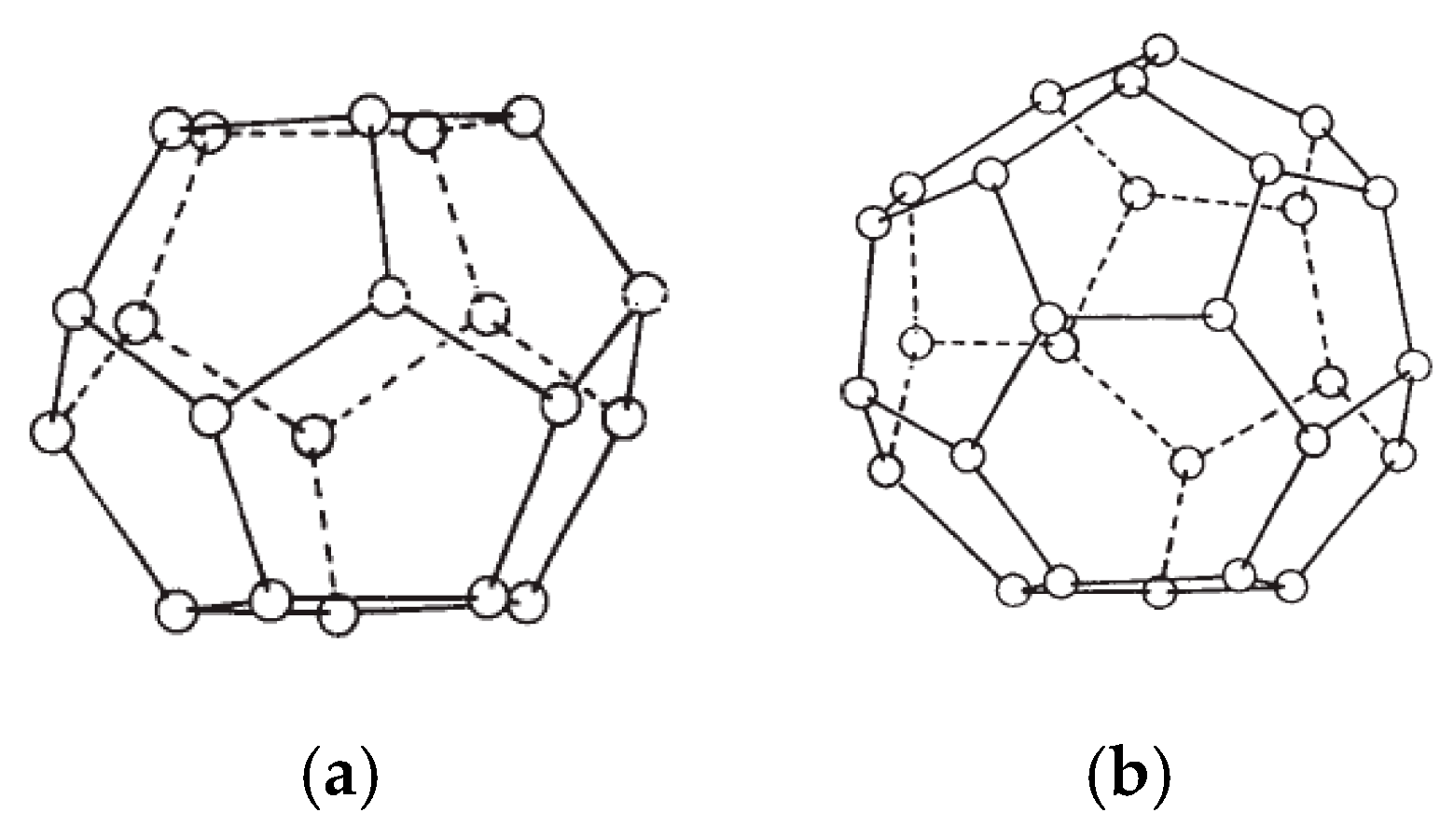

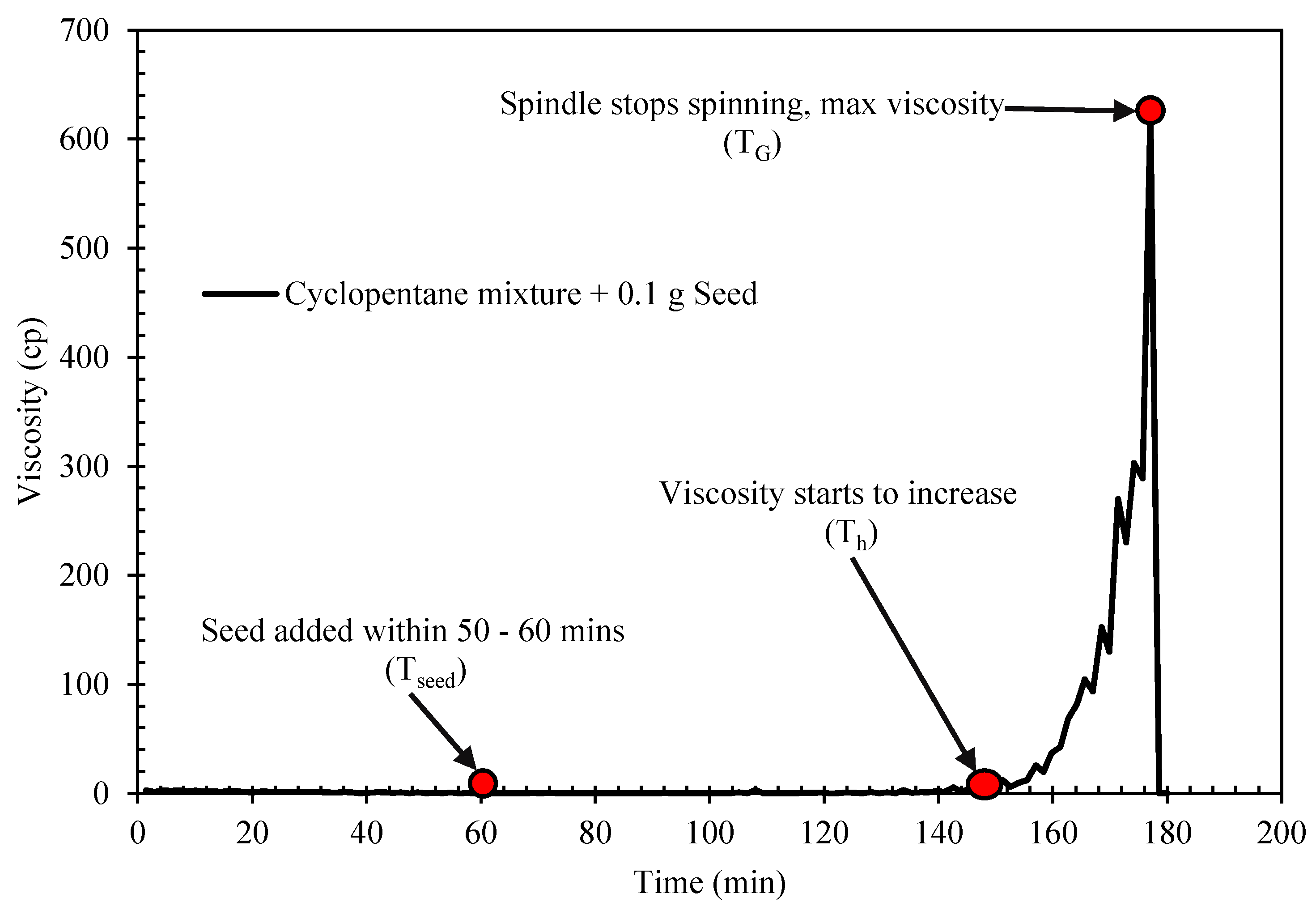
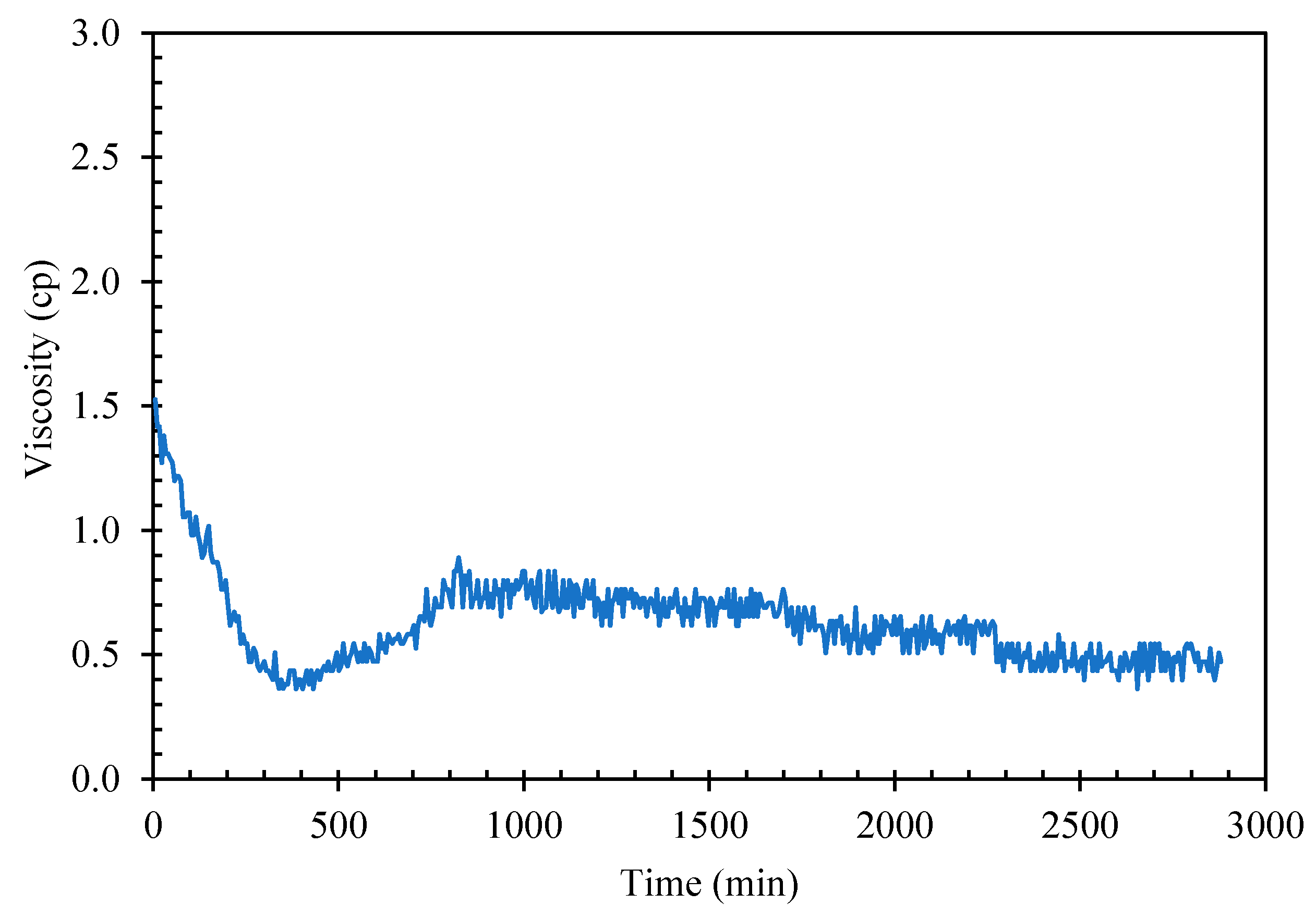

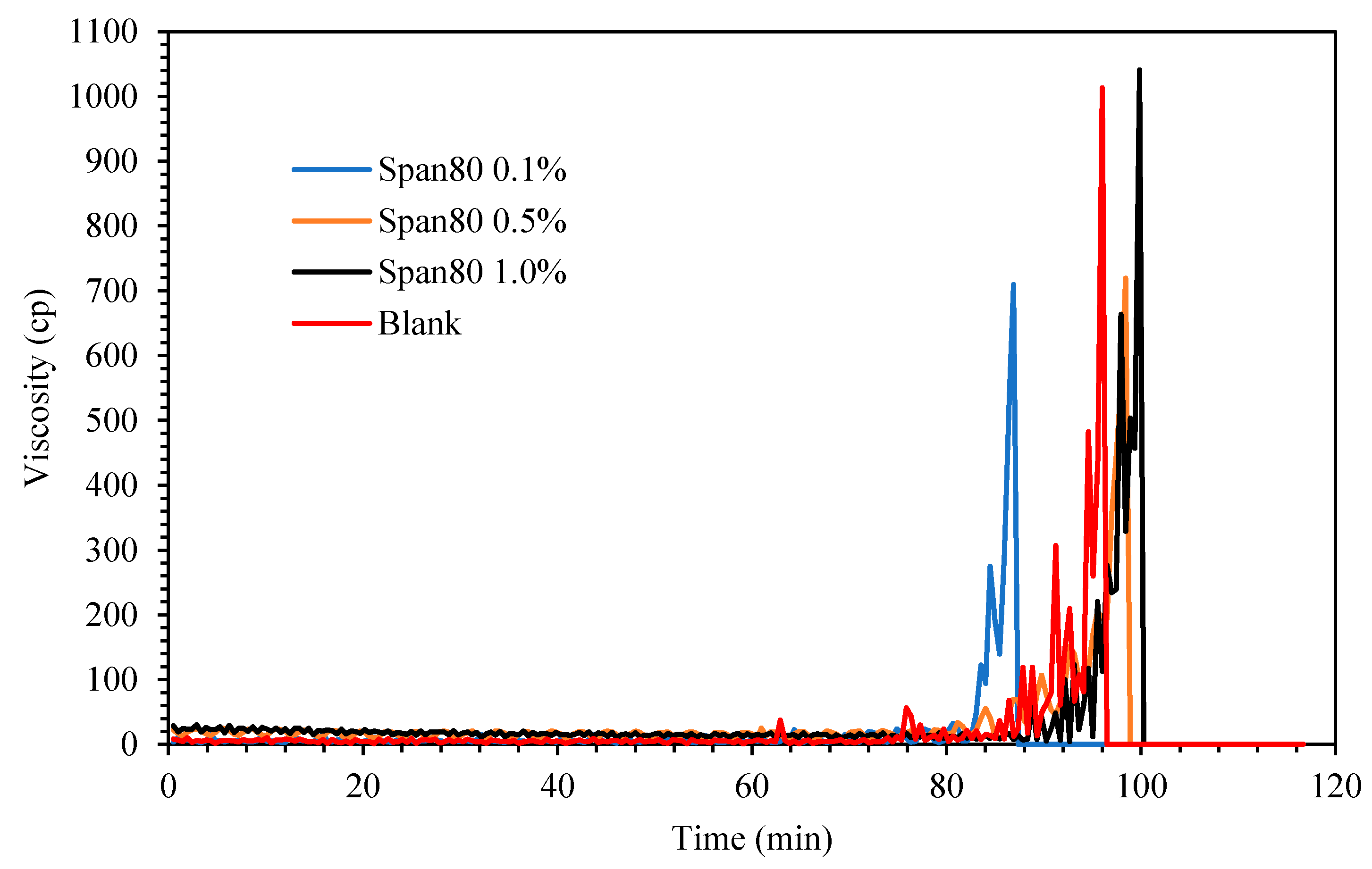

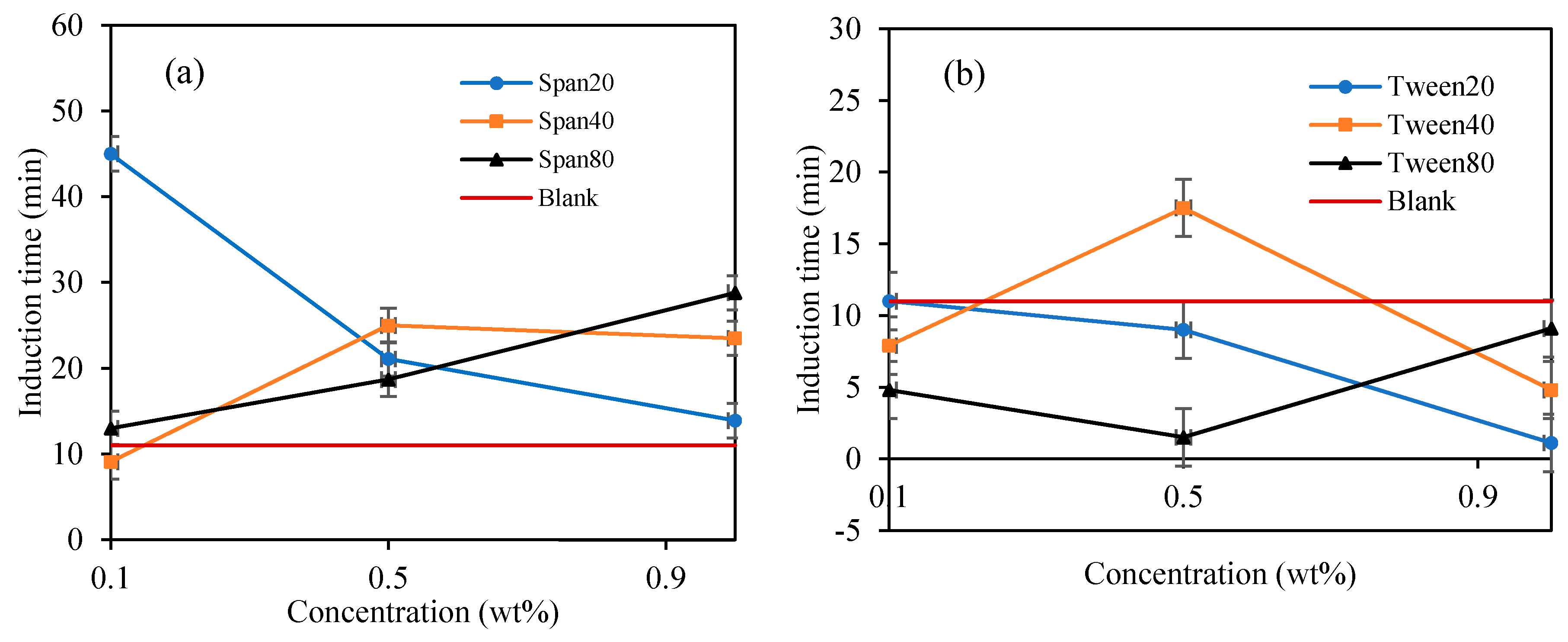

| Chemical | HLB | Density @ 25 °C (gcm−1) | Viscosity @ 25 °C (cp) | MW (gmol−1) | Supplier |
|---|---|---|---|---|---|
| Deionized water | – | 1.0 | 0.890 | 18.12 | Self |
| Cyclopentane | – | 0.751 | 0.419 | 70.1 | Sigma-Aldrich |
| Span 20 | 8.6 | 1.032 | 1000–2000 | 346.46 | Sigma-Aldrich |
| Span 40 | 6.7 | 1.075 | 1000–2000 | 402.565 | Sigma-Aldrich |
| Span 80 | 4.3 | 0.986 | 1200–2000 | 428.6 | Sigma-Aldrich |
| Tween 20 | 16.7 | 1.1 | 370–430 | 1228 | Sigma-Aldrich |
| Tween 40 | 15.6 | 1.05–1.10 | 400–600 | 1283.63 | Sigma-Aldrich |
| Tween 80 | 15.0 | 1.06–1.09 | 300–500 | 1310 | Sigma-Aldrich |
| System | Conc. (wt%) | Induction Time (min) a | Crystallization Time (min) b |
|---|---|---|---|
| Blank | – | 11 | 22 |
| Span 20 | 0.1 | 45 | 8 |
| 0.5 | 21 | 14 | |
| 1.0 | 14 | 7 | |
| Span 40 | 0.1 | 9 | 20 |
| 0.5 | 25 | 6 | |
| 1.0 | 24 | 3 | |
| Span 80 | 0.1 | 13 | 10 |
| 0.5 | 19 | 14 | |
| 1.0 | 29 | 11 | |
| Tween 20 | 0.1 | 11 | 4 |
| 0.5 | 9 | 5 | |
| 1.0 | 1 | 3 | |
| Tween 40 | 0.1 | 8 | 4 |
| 0.5 | 18 | 2 | |
| 1.0 | 5 | 4 | |
| Tween 80 | 0.1 | 5 | 3 |
| 0.5 | 2 | 2 | |
| 1.0 | 9 | 4 |
© 2020 by the authors. Licensee MDPI, Basel, Switzerland. This article is an open access article distributed under the terms and conditions of the Creative Commons Attribution (CC BY) license (http://creativecommons.org/licenses/by/4.0/).
Share and Cite
Foo, K.S.; Bavoh, C.B.; Lal, B.; Mohd Shariff, A. Rheology Impact of Various Hydrophilic-Hydrophobic Balance (HLB) Index Non-Ionic Surfactants on Cyclopentane Hydrates. Molecules 2020, 25, 3725. https://doi.org/10.3390/molecules25163725
Foo KS, Bavoh CB, Lal B, Mohd Shariff A. Rheology Impact of Various Hydrophilic-Hydrophobic Balance (HLB) Index Non-Ionic Surfactants on Cyclopentane Hydrates. Molecules. 2020; 25(16):3725. https://doi.org/10.3390/molecules25163725
Chicago/Turabian StyleFoo, Khor Siak, Cornelius Borecho Bavoh, Bhajan Lal, and Azmi Mohd Shariff. 2020. "Rheology Impact of Various Hydrophilic-Hydrophobic Balance (HLB) Index Non-Ionic Surfactants on Cyclopentane Hydrates" Molecules 25, no. 16: 3725. https://doi.org/10.3390/molecules25163725






